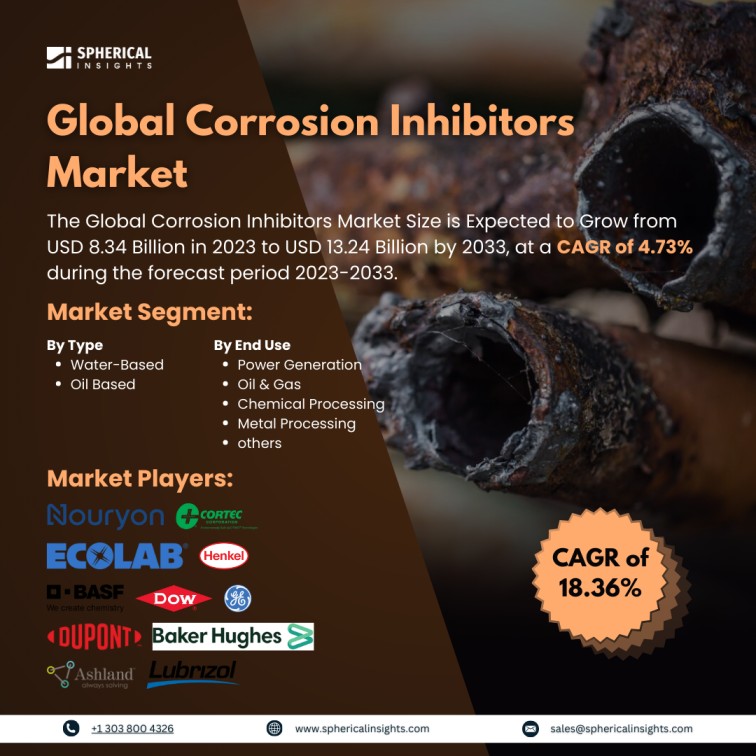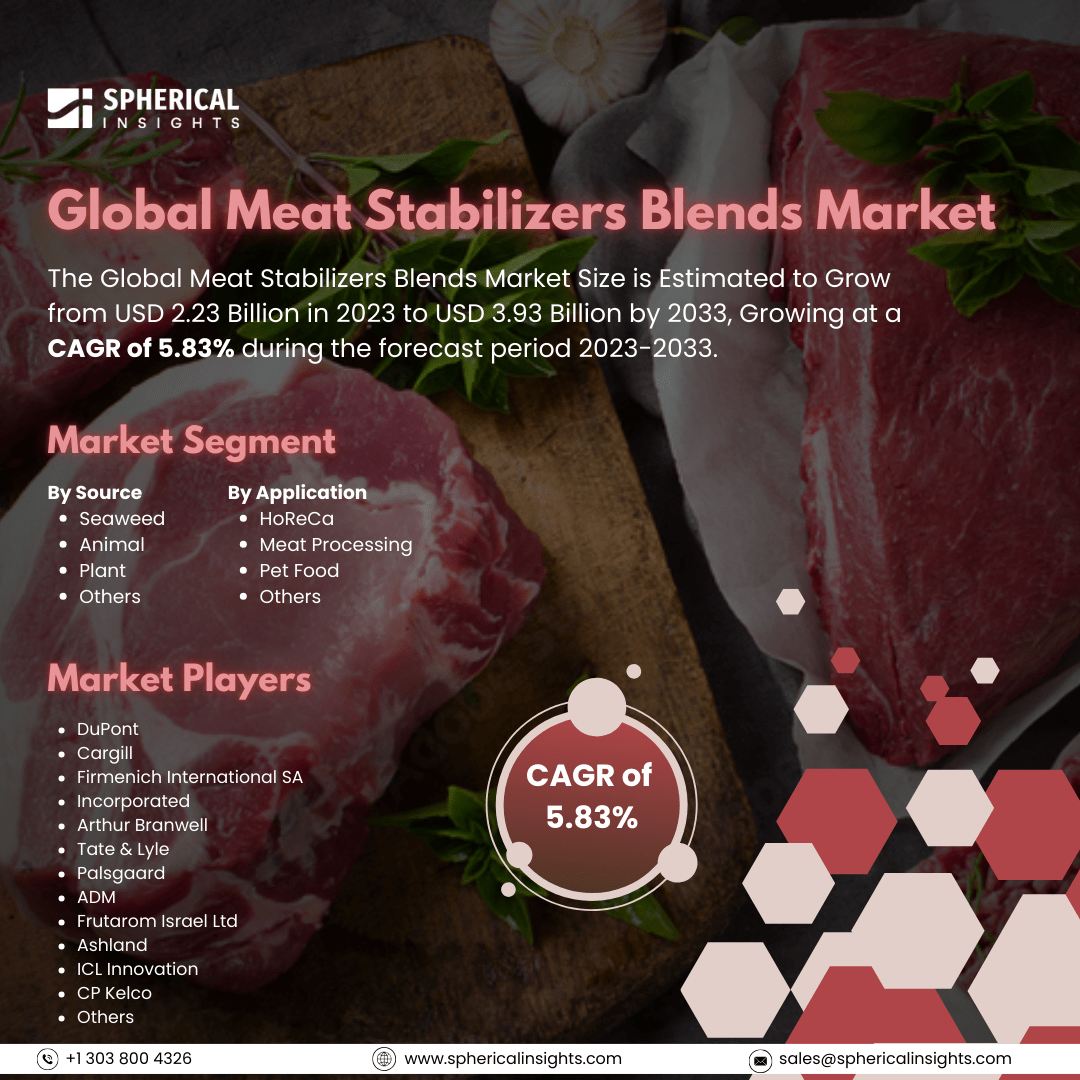Global Corrosion Inhibitors Market Size to Exceed USD 13.24 Billion by 2033
According to a research report published by Spherical Insights & Consulting, the Global Corrosion Inhibitors Market Size is Expected to Grow from USD 8.34 Billion in 2023 to USD 13.24 Billion by 2033, at a CAGR of 4.73% during the forecast period 2023-2033.
Browse 210 market data Tables and 45 Figures spread through 190 Pages and in-depth TOC on the Global Corrosion Inhibitors Market Size, Share, and COVID-19 Impact Analysis, By Type (Water-Based, Oil Based), By End Use (Power Generation, Oil & Gas, Chemical Processing, Metal Processing and others), and By Region (North America, Europe, Asia-Pacific, Latin America, Middle East, and Africa), Analysis and Forecast 2023 – 2033
The corrosion inhibitors market, in very simple terms, is the manufacturing and application of chemicals that would prevent or reduce the corrosion on the metal surfaces. These are available as liquids, powders, coatings, organic and inorganic in nature, and used within the oil and gas, automotive, construction, and water treatment industries to prevent rust and degradation of their metal components. Moreover, growth drivers for the corrosion inhibitors market are increased demand for infrastructure protection and the need for strong machinery across all industries. Industrialization growth, especially in oil and gas, automobile, and manufacturing sectors, supports market growth. Also, with a growing requirement for eco-friendly corrosion inhibitors, pressure on the requirement for non-toxic and biodegradable corrosion inhibitors is increasing so that the effect of environmental impacts and equipment durability are improved. However, corrosion inhibitors face market constraints such as high production costs, limited availability of environmentally benign alternatives, and regulatory problems related to chemical composition. Furthermore, the growing preference for less effective inhibitors and shifting raw material prices may stymie market expansion.
The water-based segment dominated the market in 2023 and is projected to grow at a CAGR during the projected timeframe.
Based on the type, the corrosion inhibitors market is divided into water-based based, oil based. Among these, the water-based segment dominated the market in 2023 and is projected to grow at a CAGR during the projected timeframe. These have been preferred in various industries for their environmentally friendly nature, lower toxicity, and easy application. This is why, in the automobile, construction, and water treatment industries, water-based inhibitors are widely used, given the importance of sustainability and compliance with environmental regulations in these sectors.
The oil & gas segment accounted for the highest share in 2023 and is anticipated to grow at a remarkable CAGR during the projected timeframe.
Based on the end use, the corrosion inhibitors market is divided into power generation, oil & gas, chemical processing, metal processing and others. Among these, the oil & gas segment accounted for the highest share in 2023 and is anticipated to grow at a remarkable CAGR during the projected timeframe. The segmental growth due to increasing demand for energy and the protection of pipelines, rigs, and other equipment from severe environmental conditions also propel the usage of corrosion inhibitors. The increasing offshore and deep-water drilling activities further boost market growth in this segment.
Asia Pacific is anticipated to hold the majority share of the global corrosion inhibitors market over the predicted timeframe.
Asia Pacific is anticipated to hold the majority share of the global corrosion inhibitors market over the predicted timeframe. This growth is driven by rapid industrialization, especially in the large economies of China and India, where the oil & gas, manufacturing, and automotive sectors are growing. Large-scale infrastructure projects undertaken across the region plus increased demand for energy make it more likely for corrosion inhibitors to be applied to machinery and equipment for protection against corrosion.
North America is expected to grow at the fastest CAGR in the global corrosion inhibitors market during the forecast period. This growth is led by the strong oil & gas industry, primarily in the U.S. and Canada, in which the application of corrosion inhibitors is necessary to maintain pipelines, rigs, and machinery. Moreover, the high focus that the region has on industrial maintenance, infrastructure, and environmental applications provides more demand for corrosion inhibitors.
Competitive Analysis
Major vendors in the global corrosion inhibitors market are Nouryon, Cortec Corporation, Ashland, Ecolab, Henkel Ibérica, S.A., The Lubrizol Company, BASF SE, Dow, DuPont de Nemours, Inc., Baker Hughes, a GE company LLC, and Other.
Market Players
- Investors
- End-users
- Government Authorities
- Consulting and Research Firm
- Venture capitalists
- Value-Added Resellers (VARs)
Recent Development
- In August 2024, PPG unveiled its newest innovation, PPG PRIMERON Optimal, a powder primer with optimized zinc for better corrosion protection. This advanced primer will enhance adhesion and durability in a variety of industrial applications. Effective corrosion inhibitors are incorporated in PPG PRIMERON Optimal to greatly extend the lifespan of coated surfaces, ensuring excellent performance in the most demanding environments. This is part of PPG's effort to provide the best solutions to meet customers' evolving needs in protective coatings.
Market Segment
This study forecasts revenue at global, regional, and country levels from 2020 to 2033. Spherical Insights has segmented the global corrosion inhibitors market based on the below-mentioned segments:
Global Corrosion Inhibitors Market, By Type
Global Corrosion Inhibitors Market, By End Use
- Power Generation
- Oil & Gas
- Chemical Processing
- Metal Processing
- others
Global Corrosion Inhibitors Market, By Regional
- North America
- Europe
- Germany
- UK
- France
- Italy
- Spain
- Russia
- Rest of Europe
- Asia Pacific
- China
- Japan
- India
- South Korea
- Australia
- Rest of Asia Pacific
- South America
- Brazil
- Argentina
- Rest of South America
- Middle East & Africa
- UAE
- Saudi Arabia
- Qatar
- South Africa
- Rest of the Middle East & Africa



